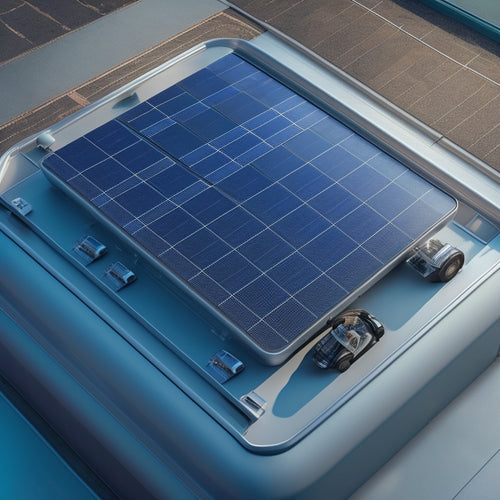
Can Solar and Wind Power Work in Your Neighborhood
Share
You can assess your neighborhood's potential for solar and wind power by evaluating key factors such as solar exposure, wind patterns, and local regulations. Consider the amount of direct sunlight your area receives daily, factoring in tree coverage, building height, and seasonal variations. Similarly, analyze wind patterns, including average wind speed and direction. Research local zoning laws, building codes, and utility incentives to guarantee a smooth implementation. By understanding these essential factors, you'll be better equipped to determine the feasibility of integrating solar and wind power into your community, and uncover the benefits that come with utilizing renewable energy sources.
Key Takeaways
- Assess your neighborhood's solar exposure by analyzing direct sunlight and wind patterns to determine renewable energy potential.
- Consider local regulations, zoning laws, and building codes to ensure safe and compliant installations.
- Evaluate the benefits of residential renewable energy, including cost savings, reduced carbon footprint, and increased property value.
- Address common objections by highlighting decreased costs, government incentives, and modern designs that integrate with properties.
- Engage your community and explore financing options, including government grants and crowdfunding, to make renewable energy a reality.
Assessing Your Neighborhood's Potential
As you contemplate utilizing solar and wind power in your neighborhood, evaluating the area's potential is a vital first step. This involves examining your location's solar exposure and wind patterns to determine the feasibility of harnessing these renewable energy sources.
To evaluate solar exposure, you'll need to take into account the amount of direct sunlight your neighborhood receives throughout the day. This can be affected by factors like tree coverage, building height, and the time of year.
You can use online tools or consult with a solar expert to determine the average daily solar radiation in your area.
Wind patterns are also significant in determining your neighborhood's potential for wind power. You'll need to analyze the average wind speed and direction in your area, as well as any potential obstructions like buildings or trees.
This information can be obtained from local weather stations or wind mapping data.
Benefits of Residential Renewable Energy
Frequently, homeowners who invest in residential renewable energy systems reap numerous benefits that extend beyond simply reducing their carbon footprint. You can experience significant cost savings on your energy bills, as renewable energy sources like solar and wind can generate electricity at a lower cost than traditional fossil fuels. Additionally, residential renewable energy systems can increase your property value, making your home more attractive to potential buyers if you decide to sell in the future.
| Benefits | Description |
|---|---|
| Cost Savings | Reduce your energy bills by generating electricity at a lower cost than traditional fossil fuels |
| Environmental Impact | Decrease your carbon footprint and contribute to a cleaner, healthier environment |
| Increased Property Value | Enhance your property value and make your home more attractive to potential buyers |
Overcoming Common Objections
While considering the installation of solar or wind power systems, you may encounter several concerns that might be holding you back from making the switch to renewable energy. One major concern is cost; however, the cost of solar panels and wind turbines has decreased considerably over the years, making them more affordable.
In addition, many governments offer incentives and tax credits to offset the initial investment.
Aesthetic issues are another common objection. You might worry that solar panels or wind turbines will affect the appearance of your property. However, modern systems are designed to be sleek and unobtrusive. Many solar panels can be integrated into your roof, while wind turbines can be installed at a distance from your home.
Maintenance worries and noise pollution are also common concerns. Solar panels require minimal maintenance, and wind turbines are designed to operate quietly.
Moreover, many systems come with warranties and maintenance agreements to alleviate any concerns. By understanding and addressing these common objections, you can make an informed decision about utilizing the power of solar and wind energy in your neighborhood.
Evaluating Local Regulations and Policies
Before installing a solar or wind power system, it is essential to evaluate the local regulations and policies governing renewable energy in your neighborhood. You don't want to invest in a system only to find out it's not allowed in your area. Start by researching your local zoning laws, which dictate how close to the property line your system can be installed. You should also look into any covenants, conditions, and restrictions (CC&Rs) that may apply to your property.
| Regulation | Description | Impact on Your System |
|---|---|---|
| Zoning laws | Govern the placement and size of solar panels or wind turbines | Affects system design and installation |
| Building codes | Guarantee safe installation and operation of your system | Impacts system cost and installation timeline |
| Utility incentives | Offer rebates or credits for renewable energy systems | Affects system cost and payback period |
| Net metering policies | Allow you to sell excess energy back to the grid | Impacts your energy savings and revenue potential |
Understanding these regulations and policies will help you maneuver the installation process and guarantee a successful project.
Making It Happen: Next Steps
You've done your research and understand the local regulations and policies governing renewable energy in your neighborhood. Now it's time to take the next steps to make solar or wind power a reality.
First, focus on community engagement. Host a meeting or workshop to educate your neighbors about the benefits of renewable energy and the potential project. This is an opportunity to address concerns, gather feedback, and build support.
Be prepared to provide detailed information on the project's scope, timeline, and budget.
Next, investigate financing options. Determine the upfront costs of the project and identify potential sources of funding. You may be eligible for government incentives, grants, or tax credits.
Research local banks or credit unions that offer loans for renewable energy projects. You can also consider crowdfunding or community-based financing models.
Develop an extensive plan that outlines the project's goals, timeline, and budget. This will help you stay organized and guarantee a successful implementation.
With a solid plan in place, you'll be well on your way to utilizing the power of solar or wind energy in your neighborhood.
Frequently Asked Questions
Can I Sell Excess Energy Back to the Grid?
You can sell excess energy back to the grid through net metering, which provides benefits like energy credits, offsetting your consumption, and potentially reducing your utility bills, depending on your utility's options and policies.
How Long Do Solar Panels and Wind Turbines Last?
You're really "breaking new ground" by investing in renewable energy! Solar panels typically last 25-30 years, with some manufacturers guaranteeing panel lifespan up to 40 years, while wind turbines boast impressive turbine durability, often exceeding 20 years of operation.
Will Renewable Energy Systems Increase Property Taxes?
You'll find that renewable energy systems typically don't increase property taxes, as tax assessments often exclude the added value from solar panels or wind turbines, leaving your property value unaffected.
Can I Install Systems in a Homeowners Association?
As you traverse the path to renewable energy, you'll face a hurdle: can you install systems in a homeowners association? Check your HOA regulations, community guidelines, and installation permits, considering aesthetic considerations, to guarantee a smooth integration of solar or wind power into your neighborhood.
Are There Any Rebates or Incentives for Low-Income Households?
You'll find rebates and incentives for low-income households through energy assistance programs, like community solar initiatives, which often offer discounted rates or free installations, helping you access clean energy while saving on your utility bills.
Related Posts
-

Top Solar Panels for Car Battery Maintenance
When selecting top solar panels for car battery maintenance, consider high-efficiency models with high wattage output...
-

What You Need to Know About RV Solar Maintenance
When you're out on the road, your RV's solar panel system is your lifeline. But without regular maintenance, you're l...
-

What Makes a Road Bike-Friendly by Design?
As you plan and design roads, incorporating features like dedicated bike lanes, smooth surfaces, and traffic calming ...


